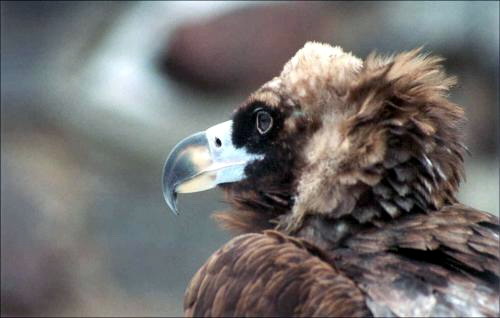|
|
Cinereous, or Eueasian Black Vulture (Aegypius monachus)
The global breeding range of Cinereous Vulture goes from the Iberian Peninsula across South-European countries and Caucasus to the Central Asia, Mongolia and China. In the CIS this raptor is a typical resident species within all study area, which conduct nomadic seasonal and vertical movements. Sometimes single birds nomade to areas, northwards of their breeding range. Such sightings were registered in the central parts of Russia, Ural Region, Siberia, Baltic countries, etc. The species breeding range in the Crimea, Northern Caucasus, Transcaucasus, Kazakhstan and Central Asia covers the open, arid areas in foothill, upland, low-and middle-mountain vertical belts. The northern border of species breeding range is going here. It is distributed as a breeding species in Ukraine (Crimea), North Caucasian region of the Russian Federation, Georgia, Armenia, Azerbaijan, Kazakhstan, Kyrgyzstan, Uzbekistan, Tadjikistan and Turkmenistan. |
|

|
|
|
|
|
|
|
|
|
|
|
MATERIAL AND METHODS
***************************************** |
|
|
|
|
******************************************************************
|
|
|
|
|
|
|
|
|
|
|
|
|
|
|
ACKNOWLEDGEMENTS
I would like to thank all those my colleagues from various organizations - professional zoologists and amateur birdlovers, who participated in my field works in Caucasus since 1972. Special great thanks are given to my best friends, former researchers from Institute of Zoology of Academy of Sciences of Georgia, Benjamin Eligulashvili (Eilat, Israel) and Gogi Rostiashvili (Moscow, Russia) for their field assistance. I would like to thank all those my colleagues from Institute of Zoology of Georgian Academy of Sciences and Bird Conservation Union of Georgia (BCUG) whose help me during collecting of materials for this publication, especially Alexander Bukhnikashvili, Andrei Kandaurov, Georgi Bakhtadze, Gia Edisherashvili, Valerii Negmedzijnov, Eristo Kvavadze, Edisher Tskhadaja, Vakhtang Pitskhelauri and David Tarkhnishvili. I also thank Professor Vladimir Galushin (Presidend of the Russian Bird Conservation Union and Vice-Chairman of the World Working Group of Birds of Prey and Owls, Moscow, Russia) for scientific consultations.
|
|
|
|


